How to create a financial forecast for a milkshake shop?
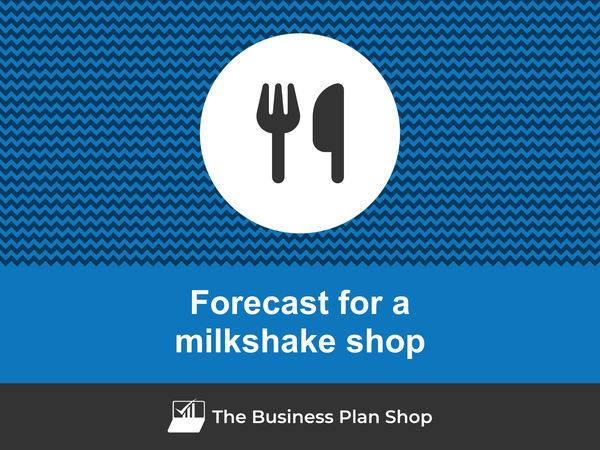
If you are serious about keeping visibility on your future cash flows, then you need to build and maintain a financial forecast for your milkshake shop.
Putting together a milkshake shop financial forecast may sound complex, but don’t worry, with the right tool, it’s easier than it looks, and The Business Plan Shop is here to guide you.
In this practical guide, we'll cover everything you need to know about building financial projections for your milkshake shop.
We will start by looking at why they are key, what information is needed, what a forecast looks like once completed, and what solutions you can use to create yours.
Let's dive in!
Why create and maintain a financial forecast for a milkshake shop?
The financial projections for your milkshake shop act as a financial blueprint to guide its growth with confidence and ensure its long-term financial viability.
To create them, you will need to look at your business in detail - from sales to operating costs and investments - to assess how much profit it can generate in the years to come and what will be the associated cash flows.
During challenging market conditions, maintaining an up-to-date financial forecast enables early detection of potential financial shortfalls, allowing for timely adjustments or securing financing before facing a cash crisis.
Your milkshake shop's financial forecast will also prove invaluable when seeking financing. Banks and investors will undoubtedly request a thorough examination of your financial figures, making precision and presentation essential.
Need a solid financial forecast?
The Business Plan Shop does the maths for you. Simply enter your revenues, costs and investments. Click save and our online tool builds a three-way forecast for you instantly.

What information is used as input to build a milkshake shop financial forecast?
A milkshake shop's financial forecast needs to be built on the right foundation: your assumptions.
The data required to create your assumptions will depend on whether you are a new or existing milkshake shop.
If you are creating (or updating) the forecast of an existing milkshake shop, then your main inputs will be historical accounting data and operating metrics, and your team’s view on what to expect for the next three to five years.
If you are building financial projections for a new milkshake shop startup, you will need to rely on market research to form your go-to-market strategy and derive your sales forecast.
For a new venture, you will also need an itemised list of resources needed for the milkshake shop to operate, along with a list of equipment required to launch the venture (more on that below).
Now that you understand what is needed, let’s have a look at what elements will make up your milkshake shop's financial forecast.
The sales forecast for a milkshake shop
The sales forecast, also called topline projection, is normally where you will start when building your milkshake shop financial forecast.
Creating a coherent sales projection boils down to estimating two key drivers:
- The average price
- The number of monthly transactions
To do this, you will need to rely on historical data (for an existing business), market research data (for both new and existing milkshake shops), and consider the elements below:
- Seasonal Demand: The demand for milkshakes may be higher during the summer months when people are looking for refreshing drinks to cool off.
- Competition: The number of competitors in the area may affect the average price of your milkshakes. If there are many other milkshake shops in the vicinity, you may need to lower your prices to remain competitive.
- Special Events: Hosting events such as concerts or festivals near your shop may attract more customers and increase the number of monthly transactions.
- Trends and Fads: The popularity of certain flavors or types of milkshakes may fluctuate over time, which could impact your average price and number of transactions.
- Ingredients: Fluctuations in the cost of ingredients, such as milk or flavorings, can affect the average price of your milkshakes and ultimately your monthly transactions.
After the sales forecast comes the operating expenses budget, which we will now look into in more detail.
Need inspiration for your business plan?
The Business Plan Shop has dozens of business plan templates that you can use to get a clear idea of what a complete business plan looks like.

The operating expenses for a milkshake shop
The next step is to estimate the expenses needed to run your milkshake shop on a day-to-day basis.
These will vary based on the level of sales expected, and the location and size of your business.
But your milkshake shop's operating expenses should include the following items at a minimum:
- Staff costs: This includes salaries, wages, and benefits for your employees, such as milkshake makers, cashiers, and cleaners.
- Ingredients: The cost of purchasing ingredients for your milkshakes, such as milk, ice cream, and flavorings.
- Packaging: This includes cups, lids, straws, and other packaging materials for your milkshakes.
- Rent: The cost of renting your shop space to operate your milkshake business.
- Utilities: This includes electricity, water, and gas bills for your shop.
- Marketing and advertising: The cost of promoting your milkshake shop through various channels, such as social media, flyers, and local advertisements.
- Accountancy fees: The cost of hiring an accountant to manage your financial records and taxes.
- Insurance: This includes general liability insurance, property insurance, and workers' compensation insurance to protect your business.
- Software licenses: The cost of purchasing software for your point-of-sale system, accounting, and inventory management.
- Banking fees: This includes transaction fees, monthly account fees, and other charges associated with your business bank account.
- Cleaning supplies: The cost of purchasing cleaning supplies to maintain the cleanliness of your shop.
- Maintenance: This includes the cost of repairing and maintaining equipment, furniture, and fixtures in your milkshake shop.
- Training and development: The cost of providing training and development opportunities for your employees to improve their skills and knowledge.
- Business license and permits: The cost of obtaining necessary licenses and permits to operate your milkshake shop.
- Taxes: The cost of paying taxes, such as sales tax and property tax, on your milkshake business.
This list is, of course, not exhaustive, and you'll have to adapt it according to your precise business model and size. A small milkshake shop might not have the same level of expenditure as a larger one, for example.
What investments are needed to start or grow a milkshake shop?
Creating and expanding a milkshake shop also requires investments which you need to factor into your financial forecast.
Capital expenditures and initial working capital items for a milkshake shop could include elements such as:
- Equipment: This includes items such as blenders, mixers, and refrigerators that are essential for making and storing milkshakes. These are considered fixed assets as they are necessary for the operation of the milkshake shop.
- Furniture and Fixtures: This category includes items such as tables, chairs, and countertops that are needed to create a comfortable and functional seating area for customers. These items are also considered fixed assets as they are not easily expendable and are necessary for the operation of the milkshake shop.
- Point of Sale System: A modern and efficient point of sale system is essential for any milkshake shop to accurately track sales and inventory. This includes hardware such as cash registers and credit card machines, as well as software for inventory management and sales reporting.
- Decor and Design: Creating an inviting and visually appealing atmosphere is important for attracting and retaining customers. This may include items such as wall decor, lighting fixtures, and signage. While these items may not directly contribute to the production of milkshakes, they are necessary for the overall success of the milkshake shop.
- Renovations and Remodeling: If you are starting a milkshake shop from scratch, you may need to invest in renovations and remodeling to create a suitable space for your business. This may include installing plumbing and electrical systems, as well as building or modifying walls and floors to meet health and safety codes.
Again, this list is not exhaustive and will need to be adjusted according to the circumstances of your milkshake shop.
Need a convincing business plan?
The Business Plan Shop makes it easy to create a financial forecast to assess the potential profitability of your projects, and write a business plan that’ll wow investors.

The financing plan of your milkshake shop
The next step in the creation of your financial forecast for your milkshake shop is to think about how you might finance your business.
You will have to assess how much capital will come from shareholders (equity) and how much can be secured through banks.
Bank loans will have to be modelled so that you can separate the interest expenses from the repayments of principal, and include all this data in your forecast.
Issuing share capital and obtaining a bank loan are two of the most common ways that entrepreneurs finance their businesses.
What tables compose the financial plan for a milkshake shop?
Now let's have a look at the main output tables of your milkshake shop's financial forecast.
The projected profit & loss statement
The projected profit & loss shows how profitable your milkshake shop is likely to be in the years to come.
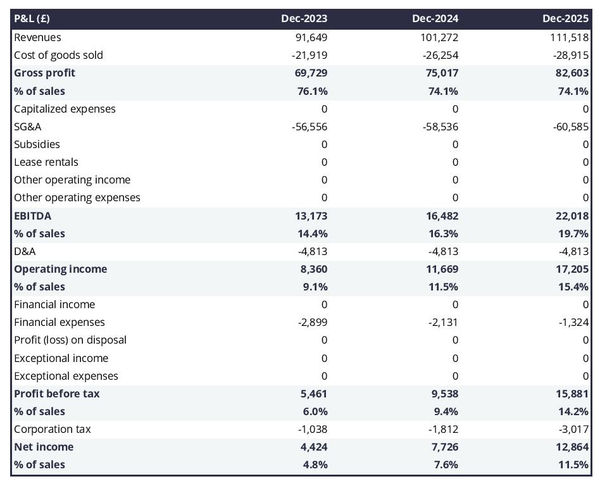
For your milkshake shop to be financially viable, your projected P&L should ideally show:
- Sales growing above inflation (the higher the better)
- Profit margins which are stable or expanding (the higher the better)
- A net profit at the end of each financial year (the higher the better)
This is for established milkshake shops, there is some leniency for startups which will have numbers that will look a bit different than existing businesses.
The projected balance sheet
Your milkshake shop's projected balance sheet provides a snapshot of your business’s financial position at year-end.
It is composed of three types of elements: assets, liabilities and equity:
- Assets: represent what the business possesses including cash, equipment, and accounts receivable (money owed by clients).
- Liabilities: represent funds advanced to the business by lenders and other creditors. They include accounts payable (money owed to suppliers), taxes payable and loans from banks and financial institutions.
- Equity: is the combination of what has been invested by the business owners and the cumulative profits and losses generated by the business to date (which are called retained earnings). Equity is a proxy for the value of the owner's stake in the business.
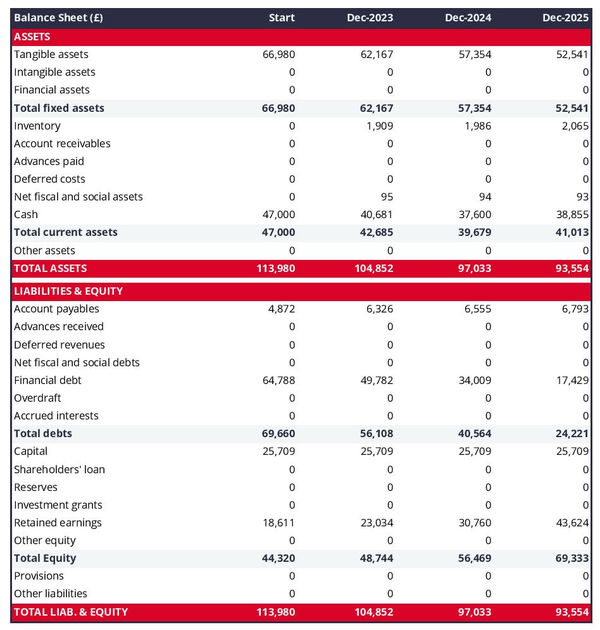
The projected cash flow statement
A projected cash flow statement for a milkshake shop is used to show how much cash the business is generating or consuming.
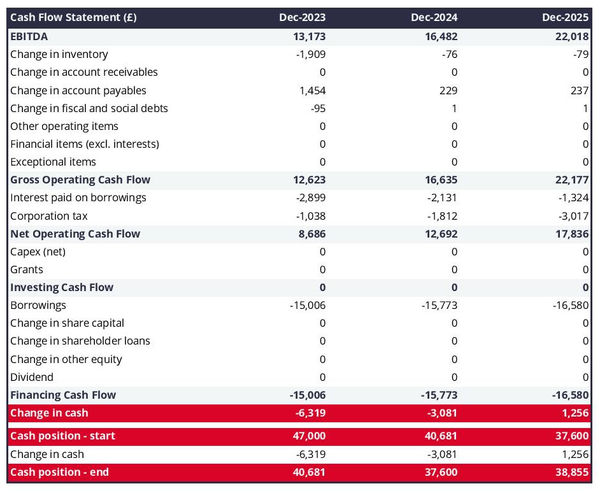
The cash flow forecast is usually organised by nature to show three key metrics:
- The operating cash flow: do the core business activities generate or consume cash?
- The investing cash flow: how much is the business investing in long-term assets (this is usually compared to the level of fixed assets on the balance sheet to assess whether the business is regularly maintaining and renewing its equipment)?
- The financing cash flow: is the business raising new financing or repaying financiers (debt repayment, dividends)?
Cash is king and keeping an eye on future cash flows is imperative for running a successful business. Therefore, you should pay close attention to your milkshake shop's cash flow forecast.
If you are trying to secure financing, note that it is customary to provide both yearly and monthly cash flow forecasts in a financial plan - so that the reader can analyze seasonal variation and ensure the milkshake shop is appropriately capitalised.
Need a solid financial forecast?
The Business Plan Shop does the maths for you. Simply enter your revenues, costs and investments. Click save and our online tool builds a three-way forecast for you instantly.

Which tool should you use to create your milkshake shop's financial forecast?
Creating your milkshake shop's financial forecast may sound fairly daunting, but the good news is that there are several ways to go about it.
Using online financial forecasting software to build your milkshake shop's projections
The modern and easiest way is to use an online financial forecasting tool such as the one we offer at The Business Plan Shop.
There are several advantages to using specialised software:
- You can easily create your financial forecast by letting the software take care of the financial calculations for you without errors
- You have access to complete financial forecast templates
- You get a complete financial forecast ready to be sent to your bank or investors
- You can easily track your actual financial performance against your financial forecast, and recalibrate your forecast as the year goes by
- You can create scenarios to stress test your forecast's main assumptions
- You can easily update your forecast as time goes by to maintain visibility on future cash flows
- You have a friendly support team on standby to assist you when you are stuck
- It’s cost-efficient and much cheaper than using an accountant or consultant (see below)
If you are interested in this type of solution, you can try our projection software for free by signing up here.
Calling in a financial consultant or chartered accountant
Outsourcing the creation of your milkshake shop financial forecast is another possible solution.
This will cost more than using software as you can expect as your price will have to cover the accountant’s time, software cost, and profit margin.
Price can vary greatly based on the complexity of your business. For a small business, from experience, a simple three-year financial forecast (including a balance sheet, income statement, and cash flow statement) will start at around £700 or $1,000.
Bear in mind that this is for forecasts produced at a single point in time, updating or tracking your forecast against actuals will cost extra.
If you decide to outsource your forecasting:
- Make sure the professional has direct experience in your industry and is able to challenge your assumptions constructively.
- Steer away from consultants using sectorial ratios to build their client’s financial forecasts (these projections are worthless for a small business).
Why not use a spreadsheet such as Excel or Google Sheets to build your milkshake shop's financial forecast?
You and your financial partners need numbers you can trust. Unless you have studied finance or accounting, creating a trustworthy and error-free milkshake shop financial forecast on a spreadsheet is likely to prove challenging.
Financial modelling is very technical by nature and requires a solid grasp of accounting principles to be done without errors. This means that using spreadsheet software like Excel or Google Sheets to create accurate financial forecasts is out of reach for most business owners.
Creating forecasts in Excel is also inefficient nowadays:
- Software has advanced to the point where forecasting can be done much faster and more accurately than manually on a spreadsheet.
- With artificial intelligence, the software is capable of detecting mistakes and helping decision-making.
Spreadsheets are versatile tools but they are not tailor-made for reporting. Importing your milkshake shop's accounting data in Excel to track actual vs. forecast is incredibly manual and tedious (and so is keeping forecasts up to date). It is much faster to use dedicated financial planning tools like The Business Plan Shop which are built specially for this.
Need a convincing business plan?
The Business Plan Shop makes it easy to create a financial forecast to assess the potential profitability of your projects, and write a business plan that’ll wow investors.

Use our financial projection templates for inspiration
The Business Plan Shop has dozens of financial forecasting templates available.
Our examples contain both the financial forecast, and a written business plan which presents, in detail, the company, the team, the strategy, and the medium-term objectives.
Whether you are just starting out or already have your own milkshake shop, looking at our template is always a good way to get ideas on how to model financial items and what to write when creating a business plan to secure funding.
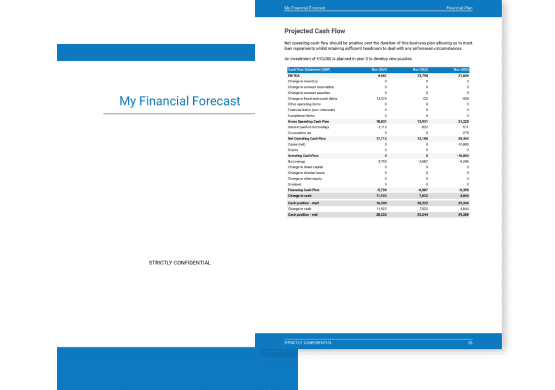
Takeaways
- Having a financial forecast enables you to visualise the expected growth, profitability, and cash generation for your business over the next three to five years.
- Tracking actuals vs. forecast and keeping your financial projections up-to-date is the only way to get a view on what your milkshake shop future cash flows may look like.
- Using financial forecasting software is the mordern and easy way to create and maintain your forecasts.
This is the end of our guide on how to build the financial forecast for a milkshake shop, we hope you found it useful. Don't hesitate to contact us if you want to share your feedback or have any questions.
Need inspiration for your business plan?
The Business Plan Shop has dozens of business plan templates that you can use to get a clear idea of what a complete business plan looks like.

Also on The Business Plan Shop
Know someone who owns or is thinking of starting a milkshake shop? Share our forecasting guide with them!




